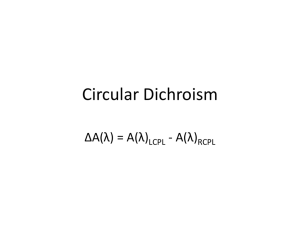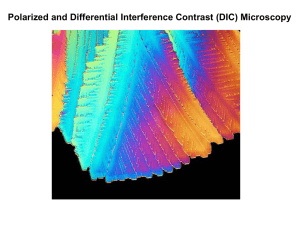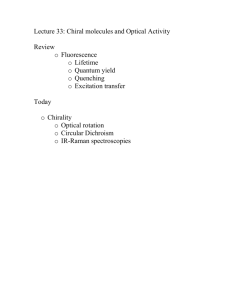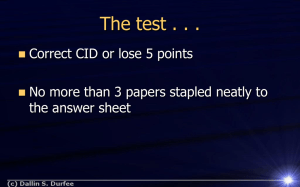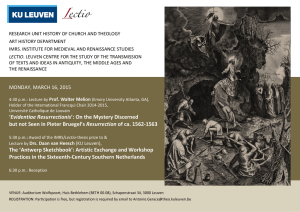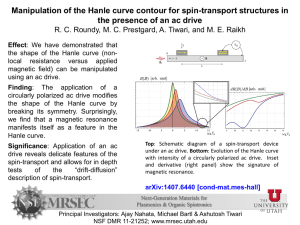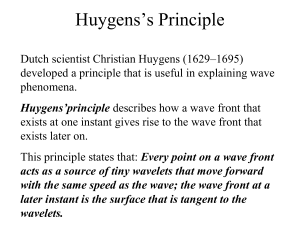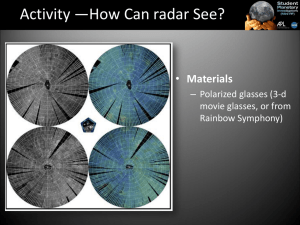View/Open
advertisement
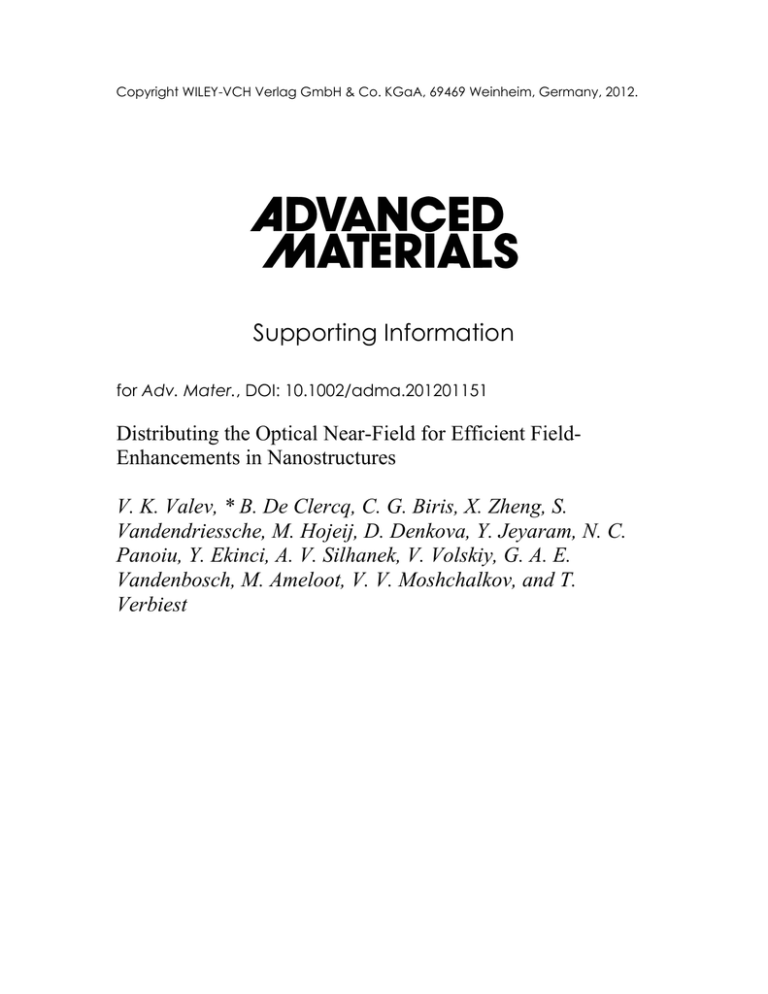
Copyright WILEY-VCH Verlag GmbH & Co. KGaA, 69469 Weinheim, Germany, 2012. Supporting Information for Adv. Mater., DOI: 10.1002/adma.201201151 Distributing the Optical Near-Field for Efficient FieldEnhancements in Nanostructures V. K. Valev, * B. De Clercq, C. G. Biris, X. Zheng, S. Vandendriessche, M. Hojeij, D. Denkova, Y. Jeyaram, N. C. Panoiu, Y. Ekinci, A. V. Silhanek, V. Volskiy, G. A. E. Vandenbosch, M. Ameloot, V. V. Moshchalkov, and T. Verbiest Submitted to Supporting Information: Distributing the optical near-field for efficient fieldenhancements in nanostructures V. K. Valev,1 B. De Clercq,2 C. G. Biris,3,4 X. Zheng,5 S. Vandendriessche,1 M. Hojeij,6 D. Denkova,7 Y. Jeyaram,7 N. C. Panoiu,3 Y. Ekinci,6 A. V. Silhanek,8 V. Volskiy,5 G. A. E. Vandenbosch,5 M. Ameloot,2 V. V. Moshchalkov7 and T. Verbiest1 1 Molecular Imaging and Photonics, INPAC, Katholieke Universiteit Leuven, Celestijnenlaan 200 D, B-3001 Leuven, Belgium 2 University Hasselt and transnational University Limburg, BIOMED, Diepenbeek, Belgium 3 Department of Electronic and Electrical Engineering, University College London, Torrington Place, London WC1E 7JE, United Kingdom. 4 Faculty of Physics, West University of Timisoara, 4 Vasile Parvan Ave., Timisoara 300223, Romania 5 ESAT-TELEMIC, Katholieke Universiteit Leuven, B-3001 Leuven, Belgium 6 Laboratory for Micro and Nanotechnology, Paul Scherrer Institute, 5232 Villigen-PS (Switzerland) and Laboratory of Metal Physics and Technology, Department of Materials, ETH Zurich, 8093 Zurich (Switzerland) 7 Nanoscale Superconductivity and Magnetism & Pulsed Fields Group, INPAC, Katholieke Universiteit Leuven, Celestijnenlaan 200 D, B-3001 Leuven, Belgium 8 Département de Physique, Université de Liège, Bât. B5, Allée du 6 août, 17, Sart Tilman, B- 4000, Belgium *Corresponding author: v.k.valev@fys.kuleuven.be website: www.valev.org In order to compare the response for circularly polarized light with that for randomly oriented linearly polarized light, we recorded SHG microscopy images from the nanostructures, upon rotating the direction of linear polarization every 5 degrees, see media file 1. For each frame, the white arrow indicates the direction of linearly polarized light. Media file 1. Second harmonic generation microscopy of the square-ring shaped gold nanostructures upon rotating the direction of linearly polarized light, indicated by the white arrow. The media file shows that the pattern of hotspots does not always follow the direction of linearly polarized light. Instead, the hotpots seem "pinned" by the strong coupling along the Y and X directions, which is shown in Figure 4a and 4b, respectively. Consequently, for randomly polarized light, the square rings exhibit a pattern of four hotspots – two along the Y and two along the X directions, not a homogeneous pattern. As additional proof, we have calculated the average SHG response for all directions of linearly polarized light, see Figure 1 Submitted to 6a. The four hotspots on each side of the square rings are clearly identifiable and are indicated with white circles. Their position is slightly shifted from the center of the sides; this shift is due to mechanical constraints, namely, the accumulated drift of the sample position stage over the time it took to acquire all the images. Consequently, while the local field response for randomly polarized light is inhomogeneous, illuminating with circularly polarized light leads to homogeneous local field enhancements. The difference originates in the fact that for randomly polarized light, the hotspots are "pinned" due to the strong coupling along the Y and X directions, while for circularly polarized light, the local field is confined to the surface of the nanostructures and distributed over it. Figure 6. In (a), the average second harmonic intensity for the 36 images in media file 1, obtained upon rotating the direction of linearly polarized light every 5°. In (b), second harmonic generation microscopy for illumination with circularly polarized light, upon increasing the laser power twice. In Figure 4c and 4d, we have shown that, illumination with circularly polarized light produces a homogeneous near-field. This homogeneity occurs at the cost of an intensity loss, as compared to the hotspots in Figure 4a and 4b. Please note that we can recover the intensity of the hotspots by increasing laser power, see Figure 6b. The image unambiguously demonstrates that the local field enhancement that would otherwise be confined to the hotspots can be distributed over the entire sample surface by using circularly polarized light. References: [1] S.A. Maier, in Plasmonics: Fundamentals and Applications, Springer, 2007. [2] T. Chen, H. Wang, G. Chen, Y. Wang, Y. Feng, W. Shan Teo, T. Wu, H. Chen, ACS Nano 2010, 4, 30873094. [3] K.H. Dostert, M. Álvarez, K. Koynov, A. del Campo, H.J. Butt, M. Kreiter, Langmuir 2012, 28, 3699-3703. [4] A. Nitzan, L.E. Brus, J. Chem. Phys. 1981, 75, 2205–2214. [5] C. J. Chen, R.M. Osgood, Phys. Rev. Lett. 1983, 50, 1705–1708. [6] D.L. Jeanmaire, R.P. Van Duyne, J. Electroanal. Chem. 1977, 84, 1–20. [7] M.G. Albrecht, J.A. Creighton, J. Am. Chem. Soc.1977, 99, 5215–5217. [8] M. I. Stockman, Top. Appl. Phys. 2006, 103, 47. [9] K. Kneipp, Y. Wang, H. Kneipp, L. T. Perelman, I. Itzkan, R. R. Dasari, M. S. Feld, Phys. Rev. Lett. 1997, 78, 1667. [10] S. Nie, S. R. Emory, Science 1997, 275, 1102. [11] V. K. Valev, A. V. Silhanek, Y. Jeyaram, D. Denkova, B. De Clercq, V. Petkov, X. Zheng, V. Volskiy, W. Gillijns, G. A. E. Vandenbosch, O. A. Aktsipetrov, M. Ameloot, V. V. Moshchalkov, T. Verbiest, Phys. Rev. Lett. 2011, 106, 226803. [12] V. K. Valev, D. Denkova, X. Zheng, A. I. Kuznetsov, C. Reinhardt, B. N. Chichkov, G. Tsutsumanova, E.J. Osley, V. Petkov, B. De Clercq, A. V. Silhanek, Y. Jeyaram, V. Volskiy, P. A. Warburton, G. A. E. Vandenbosch, S. Russev, O. A. Aktsipetrov, M. Ameloot, V. V. Moshchalkov, T. Verbiest, Adv. Mater. 2011, 24, OP29. [13] H. Cang, A. Labno, C. Lu, X. Yin, M. Liu, C. Gladden, Y. Liu, X. Zhang, Nature 2011, 469, 385–388. [14] I. I. Smolyaninov, A. V. Zayats, C. C. and Davis, Phys. Rev. B 1997, 56, 9290–9293. [15] E. J. R. Vesseur, R. de Waele, M. Kuttge, A. Polman, Nano Lett. 2007, 7, 2843-2846. [16] C. Hrelescu, T. K. Sau, A. L. Rogach, F. Jackel, G. Laurent, L. Douillard, F. Charra, Nano Letters 2011, 11, 402-407. 2 Submitted to [17] T. Kosako, Y. Kadoya, H. F. Hofmann, Nature Photonics 2010, 4, 312 - 315. [18] V. K. Valev, X. Zheng, C. G. Biris, A. V. Silhanek, V. Volskiy, B. De Clercq, O. A. Aktsipetrov, M. Ameloot, N. C. Panoiu, G. A. E. Vandenbosch, V. V. Moshchalkov, Opt. Mater. Express 2011, 1, 36-45. [19] Diffract MOD, RSoft Design Group. http://www.rsoftdesign.com [20] M. Vrancken, G. A. E. Vandenbosch, IEEE Trans. Microwave Theory Techn. 2003, 51, 216-225. [21] Y. Schols, G. A. E. Vandenbosch, IEEE Trans. Antennas Propagat. 2007, 55, 1086-1094. [22] V. K. Valev, N. Smisdom, A. V. Silhanek, B. De Clercq, W. Gillijns, M. Ameloot, V. V. Moshchalkov, T. Verbiest, Nano Lett.2009, 9, 3945. [23] J. Butet, J. Duboisset, G. Bachelier, I. Russier-Antoine, E. Benichou, C. Jonin, P.-F. Brevet, Nano Lett. 2010, 10, 1717–1721. [24] J. Butet, G. Bachelier, J. Duboisset, F. Bertorelle, I. Russier-Antoine, C. Jonin, E. Benichou, P.-F. Brevet, Opt. Express 2010, 18, 22314–22323. [25] V. K. Valev, A. Volodin, A. V. Silhanek, W. Gillijns, B. De Clercq, Y. Jeyaram, H. Paddubrouskaya, C. G. Biris, N. C. Panoiu, O. A. Aktsipetrov, M. Ameloot, V. V. Moshchalkov, T. Verbiest, ACS Nano 2011, 5, 91-96. [26] M. J. Huttunen, G. Bautista, M. Decker, S. Linden, M. Wegener, M. Kauranen, Opt. Mater. Express 2011, 1, 46-56. [27] V. K. Valev, A. V. Silhanek, B. De Clercq, W. Gillijns, Y. Jeyaram, X. Zheng, V. Volskiy, O. A. Aktsipetrov, G. A. E. Vandenbosch, M. Ameloot, V. V. Moshchalkov, T. Verbiest, Small 2011, 7, 2573-2576. [28] R. Dorn, S. Quabis, G. Leuchs, J. Mod. Opt. 2003, 50, 1917–1926. 3

